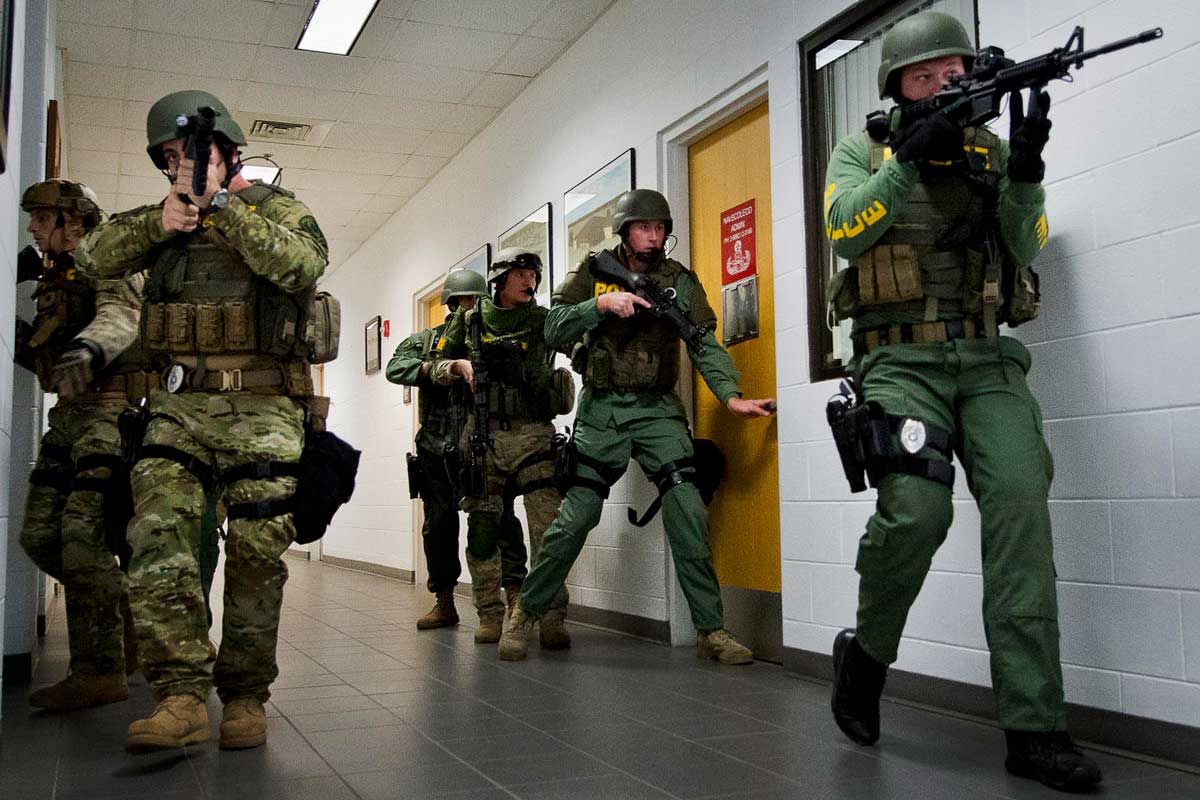
AC-110520-CQ-9-800
Stacking up, entering a room, to conduct close quarter battle (CQB) is one of the most dangerous tasks a Soldier or law enforcement officer may have to face. Some of the hardest CQB fighting U.S. forces faced, happened during the U.S occupation of Iraq in the mid-2000s from the 1st and 2nd Battles of Fallujah to taking on the Mahdi Army in Baghdad.
With Iraq being a generally flat desert country, insurgents made good use of the only cover available—urban terrain. It was during these urban operations, that Special Operations realized the standard CQB techniques that had been around forever, were not getting the job done based off, the four-man room clearing method as outlined in Battle Drill 6A.
The techniques were unnecessarily exposing friendly assaulters to enemy fire. As result, by 2006 U.S. Army Special Forces started implementing changes to the SOP on room entry and CQB to meet the real demands of urban fighting. This begs the question, “Why did the standard techniques turn out to not work so well in the first place?” Well one reason, is the fact that U.S. military CQB techniques have their roots in hostage rescue (HR) and not CQB, where destroying the enemy is the priority.
CQB AND HOSTAGE RESCUE
What is the difference between HR and CQB? Unfortunately, even in the military many do not know. Even worse, many think there actually is no difference between the two. Here’s the key difference between the two:
In HR the hostage comes first, in CQB it’s the friendly assaulter’s own life that is of importance. As previously mentioned, the Army’s foundation for how to conduct room clearing is Battle Drill 6A. Based off a 4-man team or stack.
Battle Drill 6A directs how each team member should enter and the responsibilities and sectors each member the stack should focus on and clear. The method relies on all four members of the team, entering the room almost simultaneously. Flooding the room with assaulters. with crisscrossing sectors of fire, covering all threats. Sounds good right? Unfortunately, this is HR based and not CQB based.
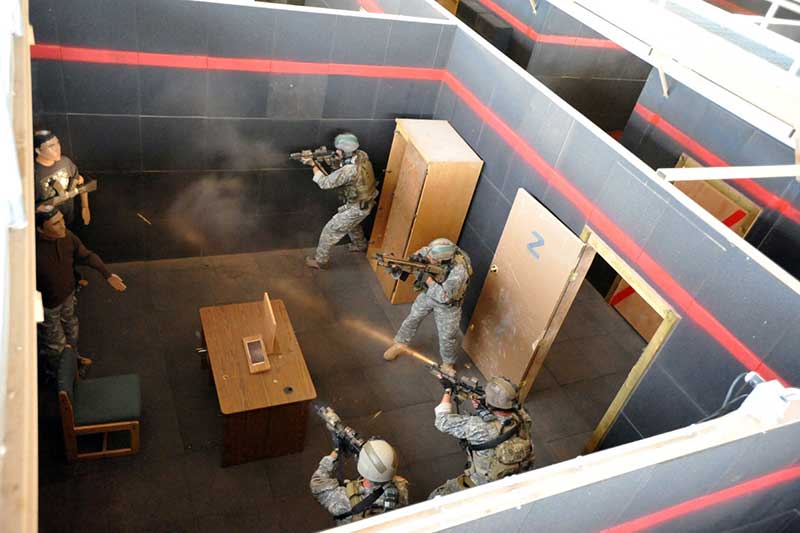
Army’s base element for CQB relies on a for-man team. During the height of fighting in Iraq
in the Mid-2000’s, SF found the four-man stack lacking when faced with real close
quarter combat. (Photo courtesy DOD).

From the enemy’s point of view: Notice no matter how tight the stack is, when the number one and two man are clearing corners first there is a gap in coverage where, if there are threats center in the room they have a chance to shoot at them before, the number three and four man enter and engage them.
In order to be able to flood the room with maximum speed with all four team members it relies on the number one and two men entering the room and clearing their corners first before engaging any targets in the center of the room. This is to basically make a safe pathway for the number three and four man to enter, so they can enter and shoot any threats in the center of the room.
But just how is this HR? Well because the number one and two man are basically drawing fire and making space for the rest of the team to come in. The whole purpose behind the team rushing in (flooding) the room is to draw attention off any hostages and force any bad guys to turn their attention to the team flowing in. Success is based off the team surprising any bad guys as they enter.
In full blown urban combat after you clear one or two rooms in a building, if there are more to clear, chances are the enemy now knows you are coming. So, no matter how fast a team might be able to enter and flow into a room. It’s not fast enough to outpace AK-47 bullets being fired from waiting and prepared insurgents.
MISCONCEPTION OF IMMEDIATE THREAT
Not buying this yet? Let’s look at the specific instructions written in 6A for the number one and number two man with regards to shooting targets. 6A states, “Number 1 and 2 man’s job is to enter the room, eliminating any immediate threat. Turn and clear corners.” So what exactly is an immediate threat? According to the Special Forces manual on Advanced Urban Combat, it is an individual (threat) that blocks access into the room.
Basically, someone standing in the door way at arms distance that physically blocks the path to get into the room. So, unless a threat is at arms distance, one and two man do not engage. They must clear their corners before they can engage. But what if the threat is on the far wall center of the room shooting at them as them make entry? The answer is no.
According to 6A and what I have experienced throughout my years of training (both regular Army and SF) the job of engaging any center threats beyond immediate threat falls on the three and four man. For the one and two man, the importance is on getting the entire team in the room. to “flood it. The importance is on getting bodies into the room and not killing the enemy. This is HR, not CQB.
Now proponents of 6A will be quick to point out that a well trained team will enter fast enough so that there is almost no gap between the one and two man entering and the three and four man. Center threats will be taken care of. Perhaps, but in real world practice wouldn’t it be common sense if there is a threat shooting at them from the center of the room for the number one guy to try and take him out as he enters?
The issue is you are relying on that number one man to be able to break from his training and perform under stress. That’s a technique counter to his training which is shoot at a threat deep in the room while moving through a door, prior to turning to clear his corner.
This is the exact situation Special Forces soldiers were having deal with while conducting operations against insurgents during height of the fighting in Iraq. Regardless of the distance from the door or if they are an immediate or not if you want any chance of getting in and clearing out the room without taking any friendly casualties you must deal with any visible threats as soon as possible, regardless where or how far into the room they are before you try and make entry.
I will not go over in detail that exact changes that were made to the Army’s room entry SOP because some of these techniques are still being employed by Special Operations. Instead I want to offer ideas to take into consideration if you are a member of a military or law enforcement team, where CQB is a part of your mission set.
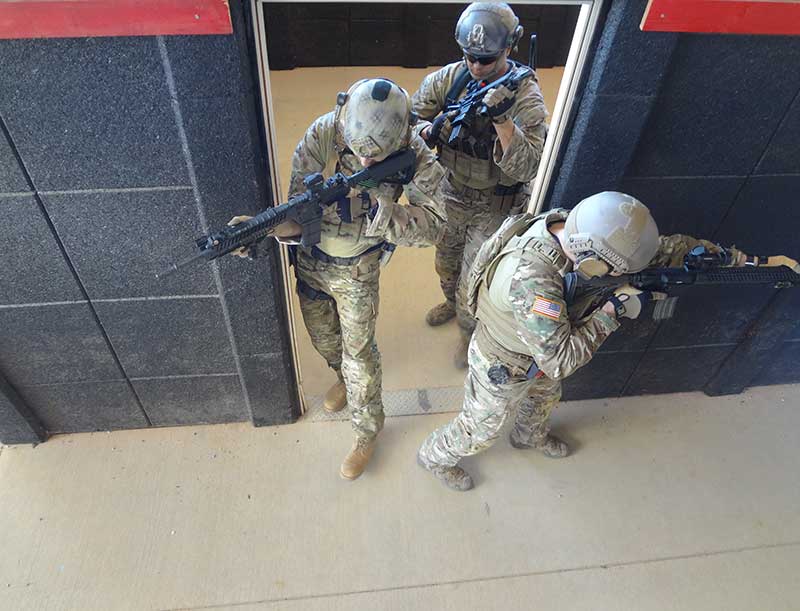
View from above showing the delay before the number three man can shoot center threats when the number one and two man clear corners first upon entry. No matter how fast the team enters there is still a split-second gap before center targets are engaged.
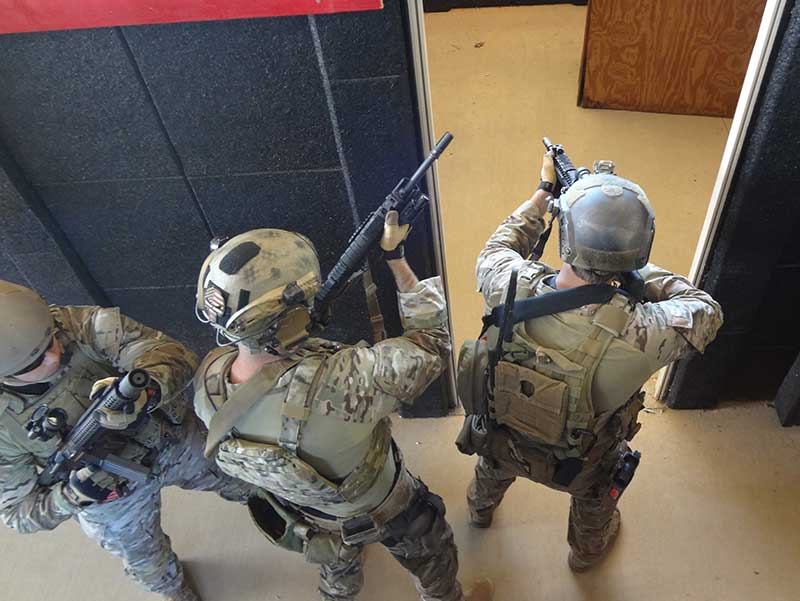
Allowing the number one man time to pie off the door and shoot any visible threats before he enters and clears a corner has proven to be a lot more effective and (safer) in combat.
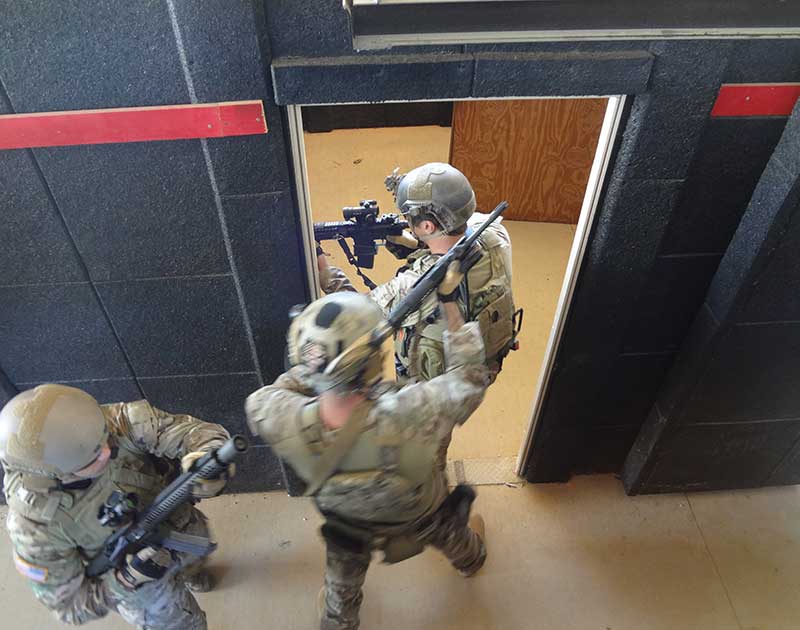
After the number one man pies the door way and shoots center threats, he then crosses
the threshold and clears a corner.
LET THE BULLET DO THE WORK FOR YOU
Why rush into a room when bullets can get there a lot faster? Prior to making room entry the number one man should be afforded the opportunity to “pie off” as much as the room as possible. Shooting threats as he sees them. There is no need to try and dominate space with friendly bodies if there are no hostages involved. Speed should come instead, in the form of how fast you can put lead into targets, not how fast you can rush into a room.
A few different techniques have been adopted allowing the one and two man, to pie the door prior to entry. But regardless if it’s a fast or slow pie off it allows the shooting of any readily visible threats prior to entry—regardless of how deep in to the room they may be standing. With this change, it has shown to be much more effective at both surprising the enemy and reduce the chances of the bad guys having time to focus on the team as they make entry, turning the door way into the dreaded fatal funnel.
Now I’m not advocating limited penetration, where the team crowds around the door and shoots in (Israeli method). Hanging out in the door way is never a good idea but before the team commits to making entry, why not put bullets in there first?
It’s a heck of a lot safer for number one man to not to have to rely on his teammates to shoot any center threats he is forced to ignore before his corner is cleared. Instead, he can now pie off as much as he can see and put bullets into bad guys then make entry and clear his corner.
THE FOLLY OF THE FOUR-MAN STACK
Another change that was made was a plus up of the size of the entry teams from four to five and even six-man teams. The problem with a four-man team, is they can find themselves outnumbered or out gunned upon entry. Only in training does it seem there is just one bad guy placed per room. This has actually created a training scar in many units.
Not so much of an issue for law enforcement, even in active shooter scenarios. Most times the threat is limited to one or two shooters. But for military units, the idea that the enemy will conveniently spread out their force in one man increments throughout the building is a lie. In real life—especially if you lost the element of surprise—there is a good chance the enemy will be occupying rooms in small groups.
Just like how U.S forces are trained to hold buildings by strong points like a room or floor—filling it up with soldiers covering all windows doors and openings—the enemy will do the same if they want to resist being taken. Plus, it’s just human nature to want to stick together when faced with danger. So, there is a good chance that if you are taking fire from a building or a room there is more than just one bad guy in it.

Note the stand-off the number one man utilizes as he pies off the door and hunts for targets. Doing so limits his exposure providing some cover before he commits to making entry.

Five-man team making entry. Again number one man instead of rushing in hoping number three and four man pick up center threats he takes a split second to pie off the door looking for any threats he can engage prior to entry.
A four-man team may not be enough to have both a numerical advantage and firepower dominance upon entry. Also, who says they just have pistols and rifles? In both Iraq and Afghanistan light machines guns have been encountered in hallways and entry ways into buildings with the intent to destroy any teams attempting room entry in which case there is a good chance you are going need more than a four-man to suppress it.
The biggest deficit with four-man teams is the inability to cover all the angles the team will be exposed to as they conduct room clearing. Now, if CQB is being conducted correctly and the building is being swarmed by half a dozen four-man teams it not such a big issue. However, if the four-man teams are spread out by even just one room’s distance or across a hall it can leave gaps in coverage that the enemy can exploit no matter how fast a team can flow into a room.
The danger will come from being shot by a bad guy hiding a few doors down, from a connecting or adjacent room or from across a hall. That is a huge problem. Unless your unit practices shooting from one room to another, more often than not it’s common for assaulters to only focus on the room they are entering. This can be a fatal mistake.
The bottom line is to ensure long angles, open door and adjoining rooms are covered, it takes more than a four-man team. If not, every time an assaulter steps out of the stack, to cover angles or uncleared areas that either leaves less men for room entry or members are forced to juggle between covering uncleared areas and trying to stay in the stack and flow into the room.
If that is the case, this is where gaps in security will happen. As soon as a bad guy sees the assaulter is not looking his way because he is trying to cover multiple doors or angles that can allow him a moment to pop out and spray the assault team with a burst of automatic fire from an AK-47.
Bumping teams up to five or six guys solves this giving you more men for both room entry, ensuring you are not outgunned by multiple bad guys. It allows for extra bodies to step out of the stack and pull security locking down uncleared sectors, open doorways and such until the team can stack up and get to them.
HALLWAYS
“Stay out of the hallway, rounds ricochet of walls and travel off it into you, blah blah blah…”. How many times have you heard this before in CQB training due to the fear of an enemy blasting rifle rounds down a hallway leads to rounds skipping off walls and turning anyone in the hallway into a bullet magnet.
Many say you should stay out of the hall, and only enter as needed to get to the next room or area to clear. My thoughts, is that this line of thinking is complete dribble.
True, when rounds hit walls they can angle off and follow along it. But thinking the team will be able to suppress any enemy every time they need to cross or travel down the hall, is flawed. In reality, by not dominating the hallway—meaning maintaining security down it—you are giving the bad guys control of the situation.
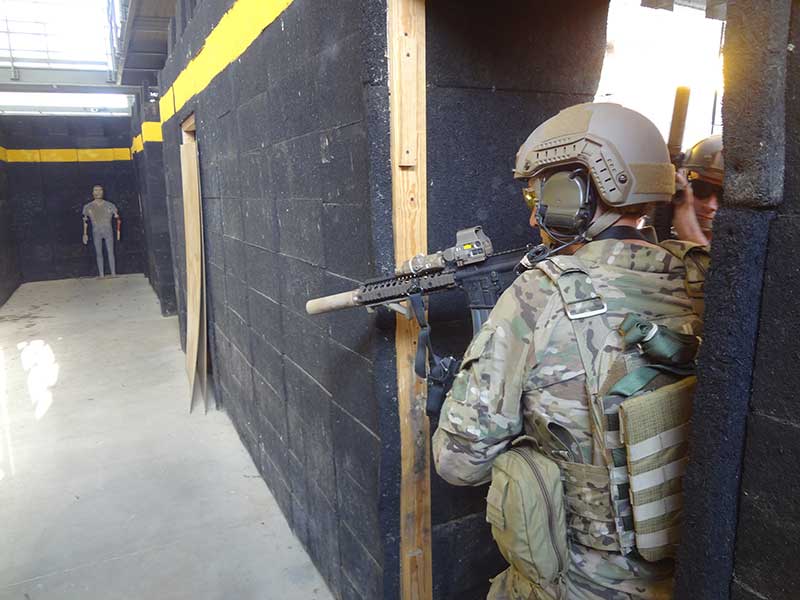
Once you fought your way into a hallway don’t give it up and give control to the enemy. Here a team member pulls security long down the hall from the room where the rest of the team has just cleared. Now every time an enemy pops out and tries to shoot or maneuver there is a lethal surprise waiting for them.
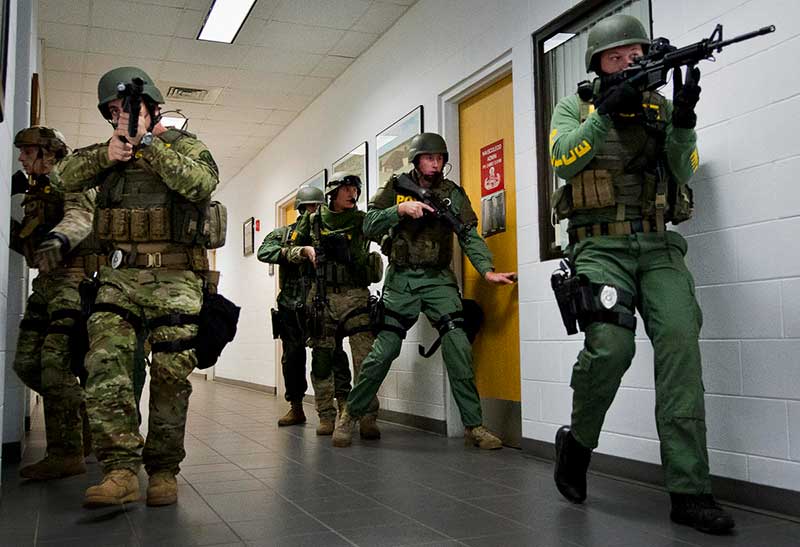
Own the hall, own the floor. Here, this law enforcement team posts two officers covering long down the hall ensuring no bad guys have a chance to shoot at the entry teams from rooms that have yet to be cleared. (Photo courtesy DOD).
It makes no sense to fight into a hallway to then give it up by flowing the entire team out of it to take down a room every time you come back out into the hallway. You are allowing the enemy a chance to turn the doorway you are coming out of into a fatal funnel. So, say you have a hallway with five rooms along it. That’s five times the team will have to refight to gain dominance of hallway.
Wouldn’t it make a lot more sense to keep control of the hallway from the get go? Why refight for the hallway after every room clearing when if you fight for it once upon entry and hold it? Now, instead of giving the enemy a chance to shoot at the team every time they come back out into the hallway the team controls it. Every time a bad guy sticks his head out of a room to try and shoot the team he will have a lethal surprise waiting for him.
This is not really an issue with law enforcement tactical teams going against active shooters. The best method has proven to be “direct to threat.” Meaning bypass rooms and go to where the gun fire is for there is a good chance there is only one or two threats. But for military teams, this is not the case.
They cannot bypass rooms. They must execute CQB based off the worst-case scenario—multiple heavily armed combatants. So, every room needs to be cleared as they come upon it. Locking down the hallway (even just one end of it) forces the enemy to expose himself to try and get at the team turning the hallway into a bullet magnet for the bad guys. Bottom line: if you own the hall, you control the situation. Why give that advantage to the enemy?
SUMMARY
If you are training in CQB, do not be afraid to ask, “why?” if the techniques you are using seem to take a lot for granted. There is a good chance that they may be based on, “this is how we have always done it” as opposed to methods developed to counter current enemy techniques and tactics.
Despite being part of an assault team, you are still responsible for your own safety.














